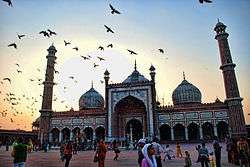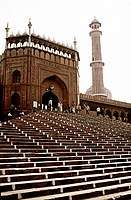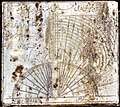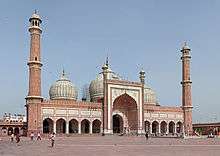Jama Masjid, Delhi
The Masjid-i Jehan Numa (lit. the 'World-reflecting Mosque' or "Mosque of the Celestial Sphere"), commonly known as the Jama Masjid of Delhi, is one of the largest mosques in India.[1] It was built by the Mughal Emperor Shah Jahan between 1650 and 1656 at a cost of one million rupees, and was inaugurated by Imam Syed Abdul Ghafoor Shah Bukhari from Bukhara, present-day Uzbekistan. The mosque was completed in 1656 AD with three great gates and two 40 metres high minarets constructed with strips of red sandstone and white marble. The courtyard can accommodate more than 25000 people. There are three domes on the terrace which are surrounded by the two minarets. On the floor, a total of 899 black borders are marked for worshippers. The architectural plan of Badshahi Masjid, built by Shah Jahan's son Aurangzeb at Lahore, Pakistan, is similar to the Jama Masjid. The Majestic Mosque for Indian Muslims is considered as the "National Mosque of India" respectively.
| Jama Masjid | |
|---|---|
 | |
| Religion | |
| Affiliation | Sunni Islam |
| Leadership | Shahi Imam : Syed Ahmed Bukhari Naib Shahi Imam : Syed Shaban Bukhari |
| Location | |
| Location | New Delhi |
| Country | India |
 Location in Delhi, India  Jama Masjid, Delhi (India) | |
| Geographic coordinates | 28.6507°N 77.2334°E |
| Architecture | |
| Type | Mosque |
| Style | Indo-Islamic, Mughal |
| Date established | 1656 |
| Construction cost | One million |
| Specifications | |
| Capacity | 25,000+ |
| Length | 40 metres (130 ft) |
| Width | 27 metres (89 ft) |
| Dome(s) | 3 |
| Minaret(s) | 2 |
| Minaret height | 41 metres (135 ft) |
| Materials | Red sandstone, marble |
| Website | |
| Jama Masjid | |
History
Mughal Emperor Shah Jahan built the Jama Masjid between 1650 and 1656. It was constructed by more than 5000 workers. It was originally called Masjid e Jahan Numa, meaning 'mosque commanding the view of the world'. The construction was done under the supervision of Saadullah Khan, wazir (or prime minister) during Shah Jahan's reign. The cost of the construction at the time was one million Rupees.[1] Shah Jahan also built the Taj Mahal, at Agra and the Red Fort in Old Delhi, which stands opposite the Jama Masjid.
The Jama Masjid was completed in 1656 AD (1066 AH).[1] The mosque was inaugurated by Imam Syed Abdul Ghafoor Shah Bukhari, from Bukhara, Uzbekistan, on 23 July 1656, on the invitation from Shah Jahan.[2] About 25,000 people can pray in the courtyard at a time .[3][4] The mosque is commonly called "Jama" which means Friday.[1]
After the British victory in the Revolt of 1857, they confiscated the mosque and stationed their soldiers there. They also wanted to destroy the mosque as an act of punishment to the city. But due to opposition faced, the demolition was not done.[5]
The iconic mosque is one of the last monuments built under Mughal Emperor Shah Jahan. After the construction of the monument in 1656, it remained the royal mosque of the emperors until the end of the Mughal period.
During 1948, the last Nizam of Hyderabad, Asaf Jah VII was asked for a donation of ₹75,000 to repair one-fourth of the mosque floor. The Nizam instead sanctioned ₹3 lakh, stating that the remaining three-fourths of the mosque should not look old.[6][7]
Modern times

In 2006, it was reported that the mosque was in urgent need of repair and then the Saudi Arabian king, Abdullah, offered to pay for it. The Imam said that he had received the offer directly from the Saudi authorities, but requested them to approach the Indian government.[8] However, the Delhi High Court said that this matter had no "legal sanctity" giving no "special equities" to the Imam.
2006 Jama Masjid explosions
On the 14th of April in 2006, there were two explosions which came soon after Friday prayers and occurred in swift succession. However it was unclear, how the blasts occurred. Among the casualties, one was in serious condition, whereas other eight people sustained minor injuries. The then imam, Bukhari commented "here is anger among our people but I am appealing to them to maintain calm".[9]
2010 Jama Masjid attack


On the 15th of September in 2010, two Taiwanese tourists were injured after gunmen on a motorcycle opened fire on a bus parked near gate number three of the mosque.[10] After the attack, the police detained 30 people to question and the area was turned into a fortress because policemen were heavily deployed.[11]
In November 2011, the Delhi Police arrested six members of the Indian Mujahideen who were believed to be behind the Jama Masjid blast along with the Pune German bakery blast. Sources said that the "'main man' Imran" allegedly planted the bomb in a car outside the mosque.[12] In September 2013 it was reported that Yasin Bhatkal, a leader of the group, along with Assadullah Akhtar, were arrested the month before and they admitted that they carried out the attack with the on-the-run Pakistani national Waqas. Yasin said that he was ordered by Karachi-based IM head Riyaz Bhatkal to do the task as the Imam allowed "semi-naked" foreigners inside it.[13]
Architecture
The mosque and Red Fort were planned to be a larger planned city named Shahjahanabad. The mosque is considered as the best among all mosques built during the Mughal Empire as it has the best mixture of marble and limestone.[14] The mosque has three great gates, four towers and two 40-metre tall minarets constructed of strips of red sandstone and smooth white marble. The northern gate has 39 steps and the southern side has 33 steps. The eastern gate was the royal entrance and has 35 steps.[15] Out of all these gateways, the eastern one, which was used by the emperors, remains closed during weekdays.[16] The mosque is built on a red sandstone porch, which is about 30 feet (9.1 m) from ground level and spreads over 1200 square metres.[1] The dome is flanked by two lofty minarets which are 130 feet (40 m) high and consists of 130 steps, longitudinally striped with marble and red sandstone.[15] The minarets consist of five storeys, each with a protruding balcony. The adjoining edifices are filled with calligraphy. The first three storeys of the minarets are made of red sandstone, the fourth of marble and the fifth of sandstone.[1]
The courtyard can accommodate 25,000 worshippers and occupies 408 square feet.[17] The mosque is about 261 feet (80 m) long and 90 feet (27 m) wide.[15] The prayer hall measures 61 metres in length and 27.5 metres in breadth.[15] It is made up of high cusped arches and marble domes. The cabinet located in the north gate has a collection of relics of Muhammad – the Quran written on deerskin, a red beard-hair of the prophet, his sandals and his footprints embedded in a marble block.[1]
The floor plan of the mosque is similar to that of the Jama Masjid of Agra.[15] It is covered with white and black ornamented marble to look like a Muslim prayer mat. Beside it, a thin black border measuring 3 feet (0.91 m) long and 1.5 feet (0.46 m) wide is marked for the Muslim worshippers. There are 899 total such boxes.[18] The architecture and plan of Badshahi Masjid, which was built by Shah Jahan's son Aurangzeb in Lahore, is closely related to that of the mosque. Before the Revolt of 1857 there was a madrasa near the southern end of the mosque, which was destroyed during the revolt.[15]
Gallery
 Inlay detail of interior arches.
Inlay detail of interior arches. Prayer area.
Prayer area. Northeast entrance Jama Masjid.
Northeast entrance Jama Masjid.- Detail of a balcony.
- Courtyard.
.jpg) Courtyard.
Courtyard. Courtyard.
Courtyard.- Exterior wall.
 A sundial in the Jama Masjid.
A sundial in the Jama Masjid. Janamaz (prayer mat) shaped on the surface.
Janamaz (prayer mat) shaped on the surface. A lamp in jama Masjid for lighting.
A lamp in jama Masjid for lighting. Arcs in the Jama Masjid.
Arcs in the Jama Masjid. Sun clock.
Sun clock. Illustration of the Eastern Gate (1795)
Illustration of the Eastern Gate (1795)
See also
Notes
- "Jama Masjid, Delhi". Cultural India website. Retrieved 19 May 2017.
- Dalrymple, p.252
- Stott and McCulloch, p.35
- "Charming Chadni Chowk" (PDF). Delhi Tourism. Retrieved 23 March 2015.
- Liddle, p.217
- "Remembering Mir Osman Ali Khan on his 51st death anniversary". Medium corporation. 24 February 2017. Retrieved 17 June 2018.
- "Surviving aides say Mir Osman Ali Khan donated generously for social causes, but did not like to spend on himself". thehindu. 25 February 2017. Retrieved 18 June 2018.
- "Saudi offer to fix Delhi mosque". BBC. Retrieved 23 March 2015.
- "Nine hurt in Delhi mosque blast". BBC. Retrieved 23 March 2015.
- "Tourists shot near Delhi mosque". BBC. 19 September 2010. Retrieved 19 May 2017.
- "4 terrorists involved in Jama Masjid firing: Intelligence sources". India Today. Retrieved 10 April 2015.
- "6 arrested for Pune blast, Jama Masjid attack". IBN Live. Retrieved 10 April 2015.
- "Cops got wrong man for Jama Masjid attack: Bhatkal". Hindustan Times. Retrieved 10 April 2015.
- Habib, Irfan (2007). Medieval India the study of a civilization. National Book Trust, India. p. 233. ISBN 978-81-237-5255-6.
- Akhter, p.270
- "Jama Masjid". Tourism India. Retrieved 23 March 2015.
- Akhter, p.269
- Akhter, p.271
References
- David Stott and Victoria McCulloch. Rajasthan, Delhi & Agra: Footprint Focus Guide. Footprint Handbooks. ISBN 1909268399.
- William Dalrymple. City of Djinns: A year in Delhi. Penguin books. ISBN 978-0-143-03106-2.
- Swapna Liddle. Delhi: 14 Historic Walks. Tranquebar Press. ISBN 9789381626245.
External links
![]()

- Photos tagged with "jamamasjid" at Flickr

